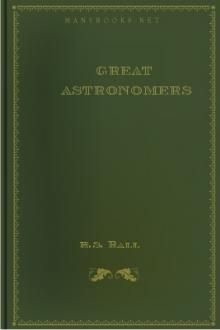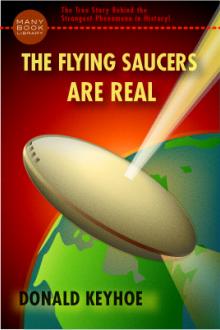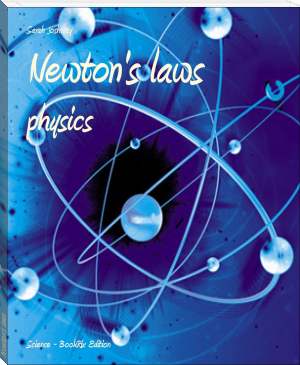Great Astronomers by Robert Stawell Ball (uplifting novels .txt) 📕

- Author: Robert Stawell Ball
- Performer: -
Book online «Great Astronomers by Robert Stawell Ball (uplifting novels .txt) 📕». Author Robert Stawell Ball
ultimately have proved successful, was necessarily a very tedious
one, but to Professor Challis, unfortunately, no other method was
available. Thus it happened that, though Challis commenced his
search at Cambridge two months earlier than Galle at Berlin, yet,
as we have already explained, the possession of accurate star-maps
by Dr. Galle enabled him to discover the planet on the very first
night that he looked for it.
The rival claims of Adams and Le Verrier to the discovery of
Neptune, or rather, we should say, the claims put forward by their
respective champions, for neither of the illustrious investigators
themselves condescended to enter into the personal aspect of the
question, need not be further discussed here. The main points of
the controversy have been long since settled, and we cannot do
better than quote the words of Sir John Herschel when he
addressed the Royal Astronomical Society in 1848:—
“As genius and destiny have joined the names of Le Verrier and
Adams, I shall by no means put them asunder; nor will they ever be
pronounced apart so long as language shall celebrate the triumphs
Of science in her sublimest walks. On the great discovery of
Neptune, which may be said to have surpassed, by intelligible and
legitimate means, the wildest pretensions of clairvoyance, it
Would now be quite superfluous for me to dilate. That glorious
event and the steps which led to it, and the various lights
in which it has been placed, are already familiar to every one
having the least tincture of science. I will only add that as
there is not, nor henceforth ever can be, the slightest rivalry on
the subject between these two illustrious men—as they have met as
brothers, and as such will, I trust, ever regard each other—we
have made, we could make, no distinction between then, on this
occasion. May they both long adorn and augment our science, and
add to their own fame already so high and pure, by fresh
achievements.”
Adams was elected a Fellow of St. John’s College, Cambridge, in
1843; but as he did not take holy orders, his Fellowship, in
accordance with the rules then existing came to an end in 1852.
In the following year he was, however, elected to a Fellowship at
Pembroke College, which he retained until the end of his life. In
1858 he was appointed Professor of Mathematics in the University
of St. Andrews, but his residence in the north was only a brief
one, for in the same year he was recalled to Cambridge as Lowndean
Professor of Astronomy and Geometry, in succession to Peacock. In
1861 Challis retired from the Directorship of the Cambridge
Observatory, and Adams was appointed to succeed him.
The discovery of Neptune was a brilliant inauguration of the
astronomical career of Adams. He worked at, and wrote upon, the
theory of the motions of Biela’s comet; he made important
corrections to the theory of Saturn; he investigated the mass of
Uranus, a subject in which he was naturally interested from its
importance in the theory of Neptune; he also improved the methods
of computing the orbits of double stars. But all these must be
regarded as his minor labours, for next to the discovery of
Neptune the fame of Adams mainly rests on his researches upon
certain movements of the moon, and upon the November meteors.
The periodic time of the moon is the interval required for one
circuit of its orbit. This interval is known with accuracy at the
present day, and by means of the ancient eclipses the period of
the moon’s revolution two thousand years ago can be also
ascertained. It had been discovered by Halley that the period
which the moon requires to accomplish each of its revolutions
around the earth has been steadily, though no doubt slowly,
diminishing. The change thus produced is not appreciable when
only small intervals of time are considered, but it becomes
appreciable when we have to deal with intervals of thousands of
years. The actual effect which is produced by the lunar
acceleration, for so this phenomenon is called, may be thus
estimated. If we suppose that the moon had, throughout the ages,
revolved around the earth in precisely the same periodic time
which it has at present, and if from this assumption we calculate
back to find where the moon must have been about two thousand
years ago, we obtain a position which the ancient eclipses show to
be different from that in which the moon was actually situated.
The interval between the position in which the moon would have
been found two thousand years ago if there had been no
acceleration, and the position in which the moon was actually
placed, amounts to about a degree, that is to say, to an arc
on the heavens which is twice the moon’s apparent diameter.
If no other bodies save the earth and the moon were present in
the universe, it seems certain that the motion of the moon
would never have exhibited this acceleration. In such a simple
case as that which I have supposed the orbit of the moon would
have remained for ever absolutely unchanged. It is, however,
well known that the presence of the sun exerts a disturbing
influence upon the movements of the moon. In each revolution our
satellite is continually drawn aside by the action of the sun from
the place which it would otherwise have occupied. These
irregularities are known as the perturbations of the lunar
orbit, they have long been studied, and the majority of them
have been satisfactorily accounted for. It seems, however, to
those who first investigated the question that the phenomenon of
the lunar acceleration could not be explained as a consequence of
solar perturbation, and, as no other agent competent to produce
such effects was recognised by astronomers, the lunar acceleration
presented an unsolved enigma.
At the end of the last century the illustrious French
mathematician Laplace undertook a new investigation of the famous
problem, and was rewarded with a success which for a long time
appeared to be quite complete. Let us suppose that the moon lies
directly between the earth and the sun, then both earth and moon
are pulled towards the sun by the solar attraction; as, however,
the moon is the nearer of the two bodies to the attracting centre
it is pulled the more energetically, and consequently there is an
increase in the distance between the earth and the moon.
Similarly when the moon happens to lie on the other side of the
earth, so that the earth is interposed directly between the moon
and the sun, the solar attraction exerted upon the earth is more
powerful than the same influence upon the moon. Consequently in
this case, also, the distance of the moon from the earth is
increased by the solar disturbance. These instances will
illustrate the general truth, that, as one of the consequences of
the disturbing influence exerted by the sun upon the earth-moon
system, there is an increase in the dimensions of the average
orbit which the moon describes around the earth. As the time
required by the moon to accomplish a journey round the earth
depends upon its distance from the earth, it follows that among
the influences of the sun upon the moon there must be an
enlargement of the periodic time, from what it would have been
had there been no solar disturbing action.
This was known long before the time of Laplace, but it did not
directly convey any explanation of the lunar acceleration. It no
doubt amounted to the assertion that the moon’s periodic time was
slightly augmented by the disturbance, but it did not give any
grounds for suspecting that there was a continuous change in
progress. It was, however, apparent that the periodic time was
connected with the solar disturbance, so that, if there were any
alteration in the amount of the sun’s disturbing effect, there
must be a corresponding alteration in the moon’s periodic time.
Laplace, therefore, perceived that, if he could discover any
continuous change in the ability of the sun for disturbing the
moon, he would then have accounted for a continuous change in
the moon’s periodic time, and that thus an explanation of the
long-vexed question of the lunar acceleration might be
forthcoming.
The capability of the sun for disturbing the earth-moon system
is obviously connected with the distance of the earth from the
sun. If the earth moved in an orbit which underwent no change
whatever, then the efficiency of the sun as a disturbing agent
would not undergo any change of the kind which was sought for.
But if there were any alteration in the shape or size of the
earth’s orbit, then that might involve such changes in the
distance between the earth and the sun as would possibly afford
the desired agent for producing the observed lunar effect. It
is known that the earth revolves in an orbit which, though
nearly circular, is strictly an ellipse. If the earth were the
only planet revolving around the sun then that ellipse would
remain unaltered from age to age. The earth is, however, only one
of a large number of planets which circulate around the great
luminary, and are guided and controlled by his supreme attracting
power. These planets mutually attract each other, and in
consequence of their mutual attractions the orbits of the planets
are disturbed from the simple elliptic form which they would
otherwise possess. The movement of the earth, for instance, is
not, strictly speaking, performed in an elliptical orbit. We may,
however, regard it as revolving in an ellipse provided we admit
that the ellipse is itself in slow motion.
It is a remarkable characteristic of the disturbing effects of
the planets that the ellipse in which the earth is at any moment
moving always retains the same length; that is to say, its longest
diameter is invariable. In all other respects the ellipse is
continually changing. It alters its position, it changes its
plane, and, most important of all, it changes its eccentricity.
Thus, from age to age the shape of the track which the earth
describes may at one time be growing more nearly a circle, or at
another time may be departing more widely from a circle. These
alterations are very small in amount, and they take place with
extreme slowness, but they are in incessant progress, and their
amount admits of being accurately calculated. At the present
time, and for thousands of years past, as well as for thousands of
years to come, the eccentricity of the earth’s orbit is
diminishing, and consequently the orbit described by the earth
each year is becoming more nearly circular. We must, however,
remember that under all circumstances the length of the longest
axis of the ellipse is unaltered, and consequently the size of the
track which the earth describes around the sun is gradually
increasing. In other words, it may be said that during the
present ages the average distance between the earth and the sun is
waxing greater in consequence of the perturbations which the earth
experiences from the attraction of the other planets. We have,
however, already seen that the efficiency of the solar attraction
for disturbing the moon’s movement depends on the distance between
the earth and the sun. As therefore the average distance between
the earth and the sun is increasing, at all events during the
thousands of years over which our observations extend, it follows
that the ability of the sun for disturbing the moon must be
gradually diminishing.
[PLATE: CAMBRIDGE OBSERVATORY.]
It has been pointed out that, in consequence of the solar
disturbance, the orbit of the moon must be some what enlarged.
As it now appears that the solar disturbance is on the whole
declining, it follows that the orbit of the





Comments (0)